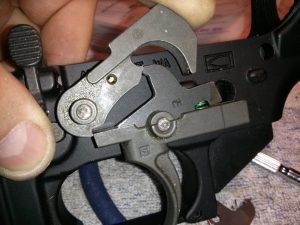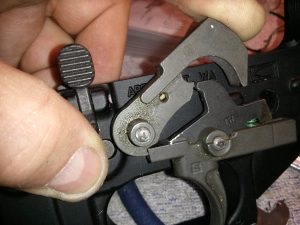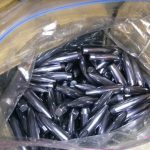My direct experience, so far, is with the Armalite NM, Kreiger-Milazzo, JP Enterprises, and the Compass Lake. All of these triggers are touted as two-stage triggers except for the JP, which is a single stage. Actually, all of the AR-15 two-stages I have seen are actually long pull single stages with a secondary trigger spring that acts through some outside mechanical means. This two-stage effect has been achieved through different means.
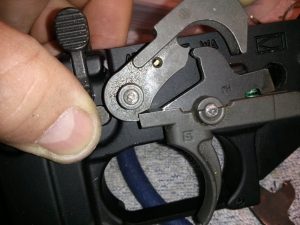 The Armalite and the Kreiger-Milazzo are essentially the same geometry, and use a clever copy of the US military double hammer hook which is found in the M1 Garand and M1A. The sear is moved from the front of the trigger, which is the standard AR-15 geometry, to the rear-top of the trigger. The disconnector is also moved to the back of the trigger. Basically, the primary sear starts in contact with the hammer hook and is only under the tension of the trigger spring until the back of the hammer contacts the front face of the disconnector (at the rear of the trigger), which, of course, is also spring loaded. At this point the pull weight becomes a summation of the trigger spring and the disconnector spring. The only real difference is that the Milazzo is adjustable without cutting.
The Armalite and the Kreiger-Milazzo are essentially the same geometry, and use a clever copy of the US military double hammer hook which is found in the M1 Garand and M1A. The sear is moved from the front of the trigger, which is the standard AR-15 geometry, to the rear-top of the trigger. The disconnector is also moved to the back of the trigger. Basically, the primary sear starts in contact with the hammer hook and is only under the tension of the trigger spring until the back of the hammer contacts the front face of the disconnector (at the rear of the trigger), which, of course, is also spring loaded. At this point the pull weight becomes a summation of the trigger spring and the disconnector spring. The only real difference is that the Milazzo is adjustable without cutting.
The Compass Lake system accomplishes the same two-stage effect in a different way. Basically, this system is based on the stock AR-15 trigger. It uses a modified trigger, hammer and safety assembly. In short, from my observations, the hammer hook has been modified to fix the over-camming effect of the hammer in the first stage in the mil-spec arrangement. The sear geometry has also been modified, I think. The real unique part is the new safety assembly.
The CL safety has added overtravel and creep adjustments. The two-stage effect is the result of a spring loaded detent that acts on the back of the trigger. It is really the same concept as the rear hammer hook type two-stages, in that the second stage results from the summation of the primary trigger spring and the detent spring in the safety. The results are really quite smooth and predictable. The two-stage is also fully adjustable and is not very complex. Second stage weight and engagement are independently adjustable. The first stage weight, as usual, is a function of the primary hammer spring.
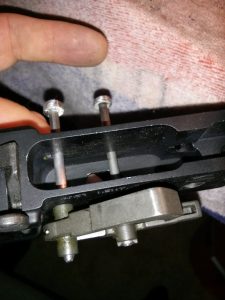 This can be a really good system for “DCM” rules, because the primary trigger spring can really be loaded up by bending the feet down creating more tension. Most of the pull weight can be moved to the first stage when a minimum pull weight is required by the rules.
This can be a really good system for “DCM” rules, because the primary trigger spring can really be loaded up by bending the feet down creating more tension. Most of the pull weight can be moved to the first stage when a minimum pull weight is required by the rules.
This system is also bad, in my opinion, because the second stage has to have creep. It is inherent in the design! If creep were to be adjusted out of the second stage, the second stage would disappear! True, in a really good trigger job, this is minimized, but I don’t see how it can last because the tolerance is so tight! Usually what happens is that some creep is built in to be on the safe side.
A two-stage design has a lot of moving parts, all of which wear. Armalite has tried to convince everyone that they can get away with not having adjustments on their trigger, don’t you believe it!
Just for the record:
- I do not like the Armalite. I will never, ever pay for a match trigger that is not adjustable without cutting. The instructions that Armalite provides for “adjusting” the creep out of the second stage (which is impossible) says that you stone on the hammer hook. Well, the hammer hook is $75 and few thousands too far, well…
- The Milazzo is sweet, but no better that the Compass Lake.
- I have few comments about the way the size of the adjustment screws on the Compass Lake, but other than that, I think the Frank White system is the best-buy in the two-stages, by far.
- Compass Lake triggers are immediately available. Bonus!
- This whole idea the Milazzo has some kind of rights to their “design” is very suspect. The whole double hook system is well used. Adjustable triggers are also very common, I find it very hard to believe that the U.S. patent office would say the Milazzo’s adjustment screw was unique. (I am in the process of applying for a patent right now, for a piece of machinery I designed).
- I ordered a Jewel two-stage in November of 1998, still no word. I Bet their product is exceptionally good, but who gives a shit! Don’t get me wrong, this is no fault of Jewel. It is not their fault their product has so much demand. I am sure they would love to sell me a trigger, me and about a million other guys.

![The Two-Stage AR-15 Trigger (1999) My direct experience, so far, is with the Armalite NM, Kreiger-Milazzo, JP Enterprises, and the Compass Lake. All of these triggers are touted as two-stage triggers except for the JP, […]](https://theurbanrifleman.com/wp-content/uploads/2013/04/CAM00339-620x300.jpg)
